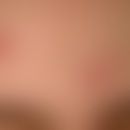Synonym(s)
DefinitionThis section has been translated automatically.
Rare, still controversial blistering disease with regard to its entity (see also Lichen planus bullosus). Some authors interpret lichen planus pemphigoides as "lichen planus bullosus" combined with a "bullous pemphigoid-like dermatosis". Other authors point out that lichen planus pemphigoides can be distinguished from bullous pemphigoid by epitope mapping, as region 4 within the C-terminus of the NC16A domain of the BP180 antigen (see COL17 A1 gene below) is said to be specific for lichen planus pemphigoides (Zillikens D et al. 1999).
EtiopathogenesisThis section has been translated automatically.
Lichen planus (ruber) pemphigoides does not appear to be a coincidence of lichen ruber and bullous pemphigoid, but a separate entity. The disease must be distinguished from bullous lichen planus in that no deposits of pathogenic autoantibodies are detectable in the skin in lichen ruber bullosus. Furthermore, the blisters in bullous lichen planus (ruber) only form in pre-existing lichen planus lesions, whereas the blisters of lichen ruber pemphigoides occur both intralesionally and on previously unaffected skin.
The etiopathogenetic role of the tumor necrosis factor in lichen planus pemphigoides is still unclear.
It is assumed that the chronic inflammatory reaction at the dermo-epidermal junction zone in lichen planus initiates a humoral autoimmune response against structural proteins of the basement membrane, in particular BP180.
In individual cases, a coincidental occurrence of lichen ruber pemphigoides and malignancies has been observed (Shimada H et al. 2015).
Drugs: In recent years, several cases of lichen ruber pemphigoides have been described as a cutaneous anti-PD-1 antibody-mediated side effect(pembrolizumab/nivolumabtherapy) in patients with metastatic malignant melanoma, among others (Schmidgen MI et al. 2017/Mueller KA et al. 2021).
Remarks: Monoclonal antibodies against programmed cell death 1 (anti-PD-1) include maculopapular, psoriasiform and lichenoid and, in rarer cases, autoimmune bullous exanthema and vitiligo.
You might also be interested in
ManifestationThis section has been translated automatically.
Mostly occurring in adulthood, well before the 6th decade.
ClinicThis section has been translated automatically.
In contrast to the lichen planus bullosus, in this variant the blisters do not (only?) occur in the lichen planus lesions, but also on unmodified skin. It is described as lesional itching and burning.
LaboratoryThis section has been translated automatically.
Common detection of circulating autoantibodies against a 180 kDa BP antigen (BPAG2, type XVII collagen).
HistologyThis section has been translated automatically.
Direct ImmunofluorescenceThis section has been translated automatically.
Perilesional skin shows linear deposits of IgG andC3 along the dermoepidermal junction zone. Not infrequently, circulating AK against the 180kDa BP antigen (BPAG2), but not against the 230kDA BP antigen, can be detected in this bullous dermatosis.
Differential diagnosisThis section has been translated automatically.
Lichen planus bullosus: No detection of BP180AK in the perilesional skin. Lesions only in pre-existing lichen planus efflorescences.
Bullous pemphigoid: No clinical evidence of lichenoid efflorescences.
TherapyThis section has been translated automatically.
According to the bullous pemphigoid. In individual cases, good therapeutic effects with ustekinumab have been described (Knisley RR et al. 2017)
Case report(s)This section has been translated automatically.
A 45-year-old patient presented with acute blistering with previously histologically confirmed lichen planus. The lichen planus consisted of generalized distribution (lichen planus exanthematicus) for about 10 months, with a relapsing course and a deterioration phase for about 5 months.
Clinical signs: Generalized papular exanthema with disseminated red, smooth papules of about 0.2-0.3 cm in size, which conflued to large plaques and showed the typical planus lichen morphology. On the lower extremities, 0.3-0.5 cm large, bulging blisters were found without an inflammatory environment.
Suspected diagnosis: Lichen planus pemphigoides / bullous Lichen ruber
Histology/immune fluorescence (perilesional): Linear deposition of C3 and IgG at the dermo-epidermal junction zone.
Laboratory: Serum detection of autoantibodies against BP180 NC16A.
Dg. Lichen planus pemphigoides
Therapy: Combination of acitretin, 20mg/day p.o. and prednisolone pulse therapy (200mg/day i.v.) and external prednicarbate cream. The blisters healed within a few weeks. After 3 months no AK was detectable. The lichen planus efflorescences also healed completely within one year.
Remark: The further course of the disease remains to be seen.
LiteratureThis section has been translated automatically.
- Hsiao CJ et al (2001) Paraneoplastic pemphigus in association with a retroperitoneal Castleman's disease presenting with a lichen planus pemphigoides-like eruption. A case report and review of literature. Br J Dermatol 144: 372-376.
- Knisley RR et al (2017) Lichen planus pemphigoides treated with ustekinumab. Cutis 100:415-418.
- Kolb-Maurer A et al (2003) Treatment of lichen planus pemphigoides with acitretin and pulsed corticosteroids. Dermatologist 54: 268-273
- Mueller KA et al (2021) A case of severe nivolumab-induced lichen planus pemphigoides in a child with metastatic spitzoid melanoma. Pediatr Dermatol 40: 154-156.
- Recke A et al (2011) Lichen planus pemphigoides. Abstract CD 46th DDG Conference DKo6/01.
- Sakuma-Oyama Y et al (2003) Lichen planus pemphigoides evolving into pemphigoid nodularis. Clin Exp Dermatol 28: 613-616
- Schmidgen MI et al (2017) Pembrolizumab-induced lichen planus pemphigoides in a patient with metastatic melanoma. J Dtsch Dermatol Ges 15:742-745.
- Shah RR et al (2022) Lichen planus pemphigoides: A unique form of bullous and lichenoid eruptions secondary to nivolumab. Dermatol Ther 35:e15432.
- Shimada H et al. (2015) Lichen planus pemphigoides concomitant with rectal adenocarcinoma: fortuitous or a true association? Eur J Dermatol 25:501-503.
- Stoebner PE et al (2003) Simvastatin-induced lichen planus pemphigoides. Ann Dermatol Venereol 130: 187-190.
- Zillikens D et al (1999) Autoantibodies in lichen planus pemphigoides react with a novel epitope within the C-terminal NC16A domain of BP180. J Invest Dermatol 113:117-121.
Incoming links (9)
DST Gene; Immune related adverse events, cutaneous; Kaposi, moriz; Lichen planus bullosus; Mucous membrane pemphigoid; Nikolsky phenomenon i; Nivolumab; Pd-1 antibody; Pembrolizumab;Outgoing links (6)
Bullous Pemphigoid ; COL17A1 gene; Lichen planus bullosus; Nivolumab; Pembrolizumab; Ustekinumab;Disclaimer
Please ask your physician for a reliable diagnosis. This website is only meant as a reference.





